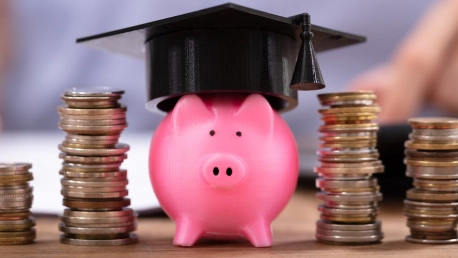The burden of student debt is no longer a new topic of discussion among American students, graduates, and government officials. However, it gained even more attention in 2022, when President Joe Biden announced his intention to forgive federal student loans. Since then, the relief plan has been blocked by a number of legal challenges, once again shading uncertainty on the financial future of millions of American students and graduates.
In this article, we look at how the situation has evolved in recent years, focusing on President Biden’s student loan forgiveness plan and its impact on individuals and the US economy.
Student Loan Debt Overview
As most American college students and their families know, earning a degree often involves significant financial sacrifice. For many, covering the costs through savings and investments is simply not possible. As a result, an increasing number of people are relying on loans to pursue higher education.
Currently, student loan debt in the US totals $1.745 trillion, of which federal loans account for 92.7% ($1.617 trillion). According to recent statistics, 42.8 million borrowers have national student debt (accounting for an average balance of $37,787), while the average total (including private loans) might be as high as $40,780. In addition, 12% of those who took out student loans are behind on their payments, according to the latest figures provided by the Federal Reserve.
However, the most recent data suggests that the debt accumulation rate is slowing—the total national student loan debt raised only 1.53% year-over-year in the second financial quarter of 2022, the lowest rate of increase in the 21st century. From the first to the second quarter of 2022, the national student loan debt balance declined by 0.12%.
President Biden’s Relief Plan
During the 2020 Presidential campaign, President Joe Biden promised to help indebted graduates. In August 2022, the first step toward fulfilling that commitment was taken, when Biden announced his plan to forgive federal student loans.
The relief plan would apply to all federal student loan borrowers earning less than $125,000 per year, or $250,000 per year for married couples, with up to $10,000 forgiven. Those who received Pell Grants will have up to $20,000 of their debt canceled. President Biden’s forgiveness plan would make a massive difference for many students and graduates, as recent Education Data Initiative statistics show that 32.2% of borrowers owe $10,000 or less in federal debt, while 74.2% owe $40,000 or less.
Biden’s relief plan doesn’t apply to private debtors, but they may be able to lower their monthly payments by refinancing. However, how much money borrowers can save depends on a number of factors relevant to their specific situation, such as the loan amount, the current and new interest rate, and the selected repayment term.
Due to concerns about its potential impact on the US economy and negative reception that led to several legal challenges, President Biden’s debt-reduction plan remains on hold for the time being.
Potential Economic Impact
Forgiving $10,000 in student loans for each borrower would cost the US government $321 billion, according to the New York Federal Reserve. However, the income cap ensures that the actual cost will be lower than that. The institution also estimated that canceling $10,000 per borrower would eliminate the student debt for 11.8 million individuals or 31% of the total debt. However, The White House indicated that this number would be 20 million debtors and nearly 90% of them earn less than $75,000 a year.
Reception and Legal Challenges
Recent reports show that 55% of Americans favor federal student loan forgiveness of up to $10,000 per borrower, 47% support cancellation of up to $50,000 per borrower, and 31% oppose student loan debt forgiveness. Furthermore, 56% of those who strongly support student loan forgiveness earn less than $50,000 a year, while 14.3% earn more than $100,000.
The program faces serious opposition, particularly from Republicans. They consider it unfair to those who have paid off their loans or never attended college and claim that President Biden’s forgiveness plan could exacerbate inflation. As early as September 2022, Nebraska, Missouri, Arkansas, Iowa, Kansas, and South Carolina filed a lawsuit against the President, the Secretary of Education Miguel Cardona, and the Department of Education. In a memorandum opinion, The Justice Department argued that the Higher Education Relief Opportunities for Students (HEROES) Act of 2003 allows the department to authorize extensive debt forgiveness during national emergencies, such as the COVID-19 pandemic. However, the state challengers said the federal government exceeded its authority by ordering debt cancellation. In October, US District Judge Henry Edward Autrey dismissed the six states’ lawsuit against President Biden, saying the action wasn’t permissible.
In October, the student loan forgiveness application was opened, despite a growing number of legal challenges. The lawsuit filed by the six Republican states was shortly followed by many others, culminating with the US Court of Appeals for the Eighth Circuit issuing an emergency order in November to block the forgiveness plan temporarily. On November 11th, The Department of Education stopped accepting applications for student loan forgiveness.
According to a statement by White House Press Secretary Karine Jean-Pierre, “President Biden will keep fighting against efforts to rob middle-class families of the relief they need and deserve.”
What’s Next?
In response to the blocking of the student loan relief plan, the Biden-Harris Administration announced that the suspension of the repayment (which was set to expire on the last day of 2022), will be extended until June 30th, 2023. “The extension will alleviate uncertainty for borrowers as the Biden-Harris Administration asks the Supreme Court to review the lower-court orders that are preventing the Department from providing debt relief for tens of millions of Americans,” according to the press release from the Department of Education.









